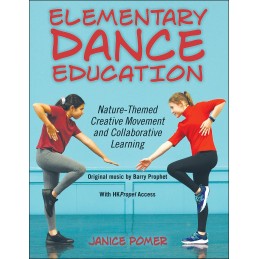Children love to observe, explore, learn, and create.
Elementary Dance Education helps them do all four. And it does so in a unique way, shaping its movement activities around nature themes. In fact, all of the learning experiences are based on different aspects of nature, as the text intertwines childrens innate curiosity and observation skills with the processes of scientific inquiry and artistic creation.
Elementary Dance Education helps teachers develop the instructional skills they need to incorporate dance into their curricula, providing over 70 movement activities and exercises for students in grades K-6. The activities, which stimulate childrens minds and bodies through the process of collaborative dance creation, include variations for younger and older students. Ideas are offered for partner or small-group explorations, making the activities more inclusive and appropriate for each age group.
Another unique feature of this book is the original music accompanying it. Teachers have access to 90 minutes of dynamic sounds, rhythmic percussion, captivating electro-acoustic compositions, and gentle atmospheric selections, delivered through HK
Propel, to accompany the learning experiences. The compositions support students movement explorations, conveying a range of images and emotions and inspiring a variety of responses.
In addition,
Elementary Dance Education offers the following::
- Discussion questions for each exercise, prompting in-class discussion and student exploration; the questions come with sample answers or ideas to encourage student responses and spur a fruitful discussion
- 75 photos and several diagrams to illustrate positions and poses and stimulate ideas for the movement exercises
- Journal prompts, tailored for older and younger children, to give students the opportunity to respond and reflect on the learning experiences
- Video links (provided in HKPropel) to help illustrate concepts and exercises, offer examples, or encourage students to watch for something specific in an activity
The books first chapter introduces the basic elements of dance; the remaining seven chapters offer movement exercises in various areas of nature:: plants, animals, water, earth, sky, people, and other wonders.
This book is a rich and easy-to-implement resource not only for elementary dance educators and physical educators but for classroom teachers as well. The exercises in this book use a template for movement discovery in which students will observe, explore, create, and share. This template “can be applied to all areas of the curriculum,” says author Janice Pomer. “Its an invaluable tool for student engagement, satisfying childrens capacity to watch, wonder, move, interact, discover, and share.”
Elementary Dance Education will promote childrens creativity and curiosity, engage and challenge their minds and bodies, and help them learn to appreciate and support each other as they work together exploring, creating, and sharing their ideas and insights about the natural world through dance.
Note:: A code for accessing HK
Propel is included with all new print books.


 Dostawa
Dostawa
 Płatność
Płatność
 Zwroty
Zwroty
